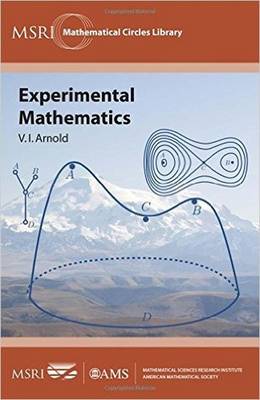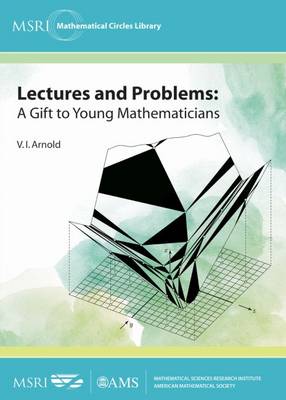MSRI Mathematical Circles Library
2 total works
One of the traditional ways mathematical ideas and even new areas of mathematics are created is from experiments. One of the best-known examples is that of the Fermat hypothesis, which was conjectured by Fermat in his attempts to find integer solutions for the famous Fermat equation. This hypothesis led to the creation of a whole field of knowledge, but it was proved only after several hundred years.
This book, based on the author's lectures, presents several new directions of mathematical research. All of these directions are based on numerical experiments conducted by the author, which led to new hypotheses that currently remain open, i.e., are neither proved nor disproved. The hypotheses range from geometry and topology (statistics of plane curves and smooth functions) to combinatorics (combinatorial complexity and random permutations) to algebra and number theory (continuous fractions and Galois groups). For each subject, the author describes the problem and presents numerical results that led him to a particular conjecture. In the majority of cases there is an indication of how the readers can approach the formulated conjectures (at least by conducting more numerical experiments).
Written in Arnold's unique style, the book is intended for a wide range of mathematicians, from high school students interested in exploring unusual areas of mathematics on their own, to college and graduate students, to researchers interested in gaining a new, somewhat nontraditional perspective on doing mathematics. In the interest of fostering a greater awareness and appreciation of mathematics and its connections to other disciplines and everyday life, MSRI and the AMS are publishing books in the Mathematical Circles Library series as a service to young people, their parents and teachers, and the mathematics profession.
This book, based on the author's lectures, presents several new directions of mathematical research. All of these directions are based on numerical experiments conducted by the author, which led to new hypotheses that currently remain open, i.e., are neither proved nor disproved. The hypotheses range from geometry and topology (statistics of plane curves and smooth functions) to combinatorics (combinatorial complexity and random permutations) to algebra and number theory (continuous fractions and Galois groups). For each subject, the author describes the problem and presents numerical results that led him to a particular conjecture. In the majority of cases there is an indication of how the readers can approach the formulated conjectures (at least by conducting more numerical experiments).
Written in Arnold's unique style, the book is intended for a wide range of mathematicians, from high school students interested in exploring unusual areas of mathematics on their own, to college and graduate students, to researchers interested in gaining a new, somewhat nontraditional perspective on doing mathematics. In the interest of fostering a greater awareness and appreciation of mathematics and its connections to other disciplines and everyday life, MSRI and the AMS are publishing books in the Mathematical Circles Library series as a service to young people, their parents and teachers, and the mathematics profession.
Vladimir Arnold (1937-2010) was one of the great mathematical minds of the late 20th century. He did significant work in many areas of the field. On another level, he was keeping with a strong tradition in Russian mathematics to write for and to directly teach younger students interested in mathematics. This book contains some examples of Arnold's contributions to the genre.
``Continued Fractions'' takes a common enrichment topic in high school math and pulls it in directions that only a master of mathematics could envision.
``Euler Groups'' treats a similar enrichment topic, but it is rarely treated with the depth and imagination lavished on it in Arnold's text. He sets it in a mathematical context, bringing to bear numerous tools of the trade and expanding the topic way beyond its usual treatment.
In ``Complex Numbers'' the context is physics, yet Arnold artfully extracts the mathematical aspects of the discussion in a way that students can understand long before they master the field of quantum mechanics.
``Problems for Children 5 to 15 Years Old'' must be read as a collection of the author's favorite intellectual morsels. Many are not original, but all are worth thinking about, and each requires the solver to think out of his or her box. Dmitry Fuchs, a long-term friend and collaborator of Arnold, provided solutions to some of the problems. Readers are of course invited to select their own favorites and construct their own favorite solutions.
In reading these essays, one has the sensation of walking along a path that is found to ascend a mountain peak and then being shown a vista whose existence one could never suspect from the ground.
Arnold's style of exposition is unforgiving. The reader--even a professional mathematician--will find paragraphs that require hours of thought to unscramble, and he or she must have patience with the ellipses of thought and the leaps of reason. These are all part of Arnold's intent.
In the interest of fostering a greater awareness and appreciation of mathematics and its connections to other disciplines and everyday life, MSRI and the AMS are publishing books in the Mathematical Circles Library series as a service to young people, their parents and teachers, and the mathematics profession.
``Continued Fractions'' takes a common enrichment topic in high school math and pulls it in directions that only a master of mathematics could envision.
``Euler Groups'' treats a similar enrichment topic, but it is rarely treated with the depth and imagination lavished on it in Arnold's text. He sets it in a mathematical context, bringing to bear numerous tools of the trade and expanding the topic way beyond its usual treatment.
In ``Complex Numbers'' the context is physics, yet Arnold artfully extracts the mathematical aspects of the discussion in a way that students can understand long before they master the field of quantum mechanics.
``Problems for Children 5 to 15 Years Old'' must be read as a collection of the author's favorite intellectual morsels. Many are not original, but all are worth thinking about, and each requires the solver to think out of his or her box. Dmitry Fuchs, a long-term friend and collaborator of Arnold, provided solutions to some of the problems. Readers are of course invited to select their own favorites and construct their own favorite solutions.
In reading these essays, one has the sensation of walking along a path that is found to ascend a mountain peak and then being shown a vista whose existence one could never suspect from the ground.
Arnold's style of exposition is unforgiving. The reader--even a professional mathematician--will find paragraphs that require hours of thought to unscramble, and he or she must have patience with the ellipses of thought and the leaps of reason. These are all part of Arnold's intent.
In the interest of fostering a greater awareness and appreciation of mathematics and its connections to other disciplines and everyday life, MSRI and the AMS are publishing books in the Mathematical Circles Library series as a service to young people, their parents and teachers, and the mathematics profession.

